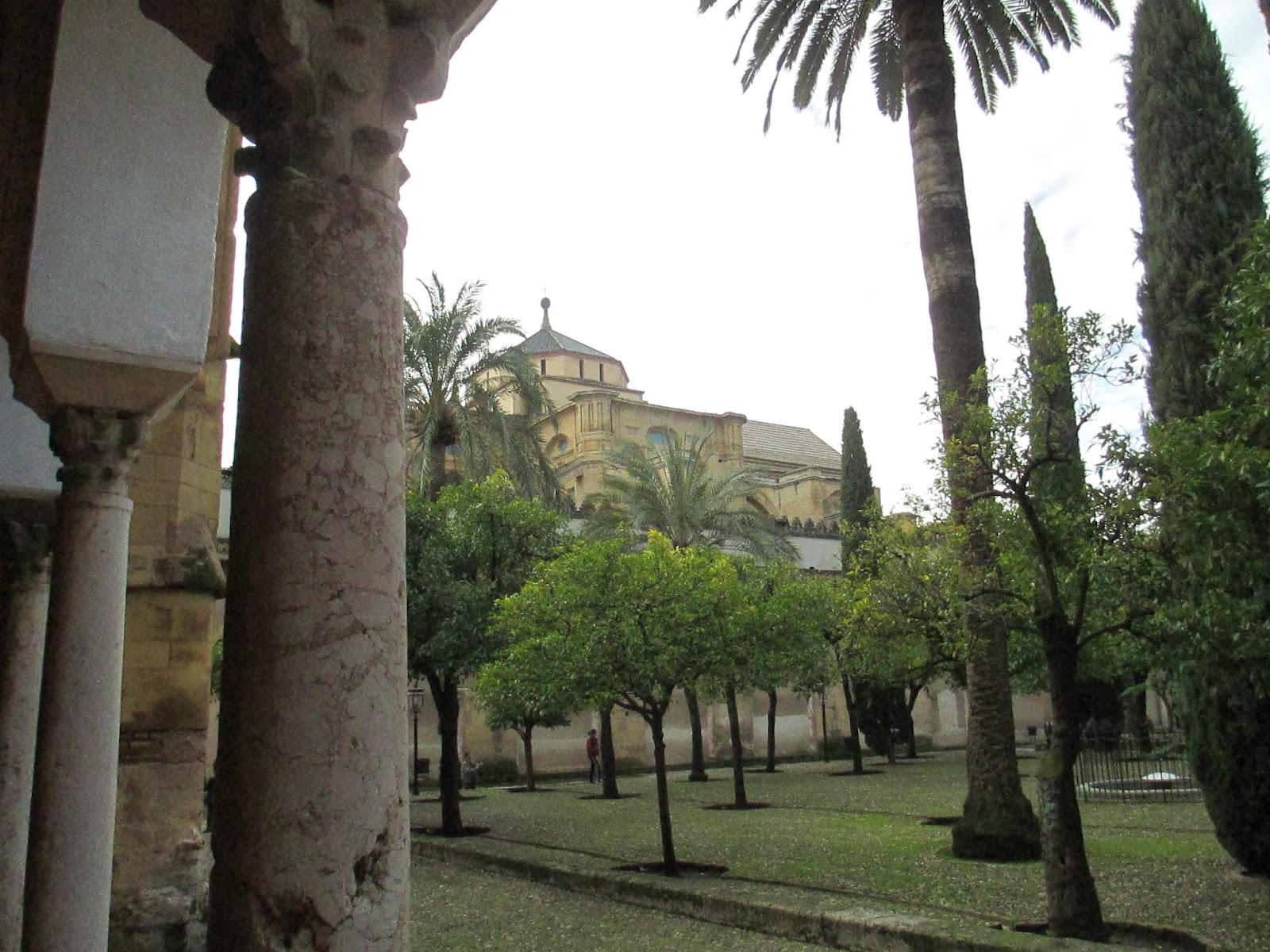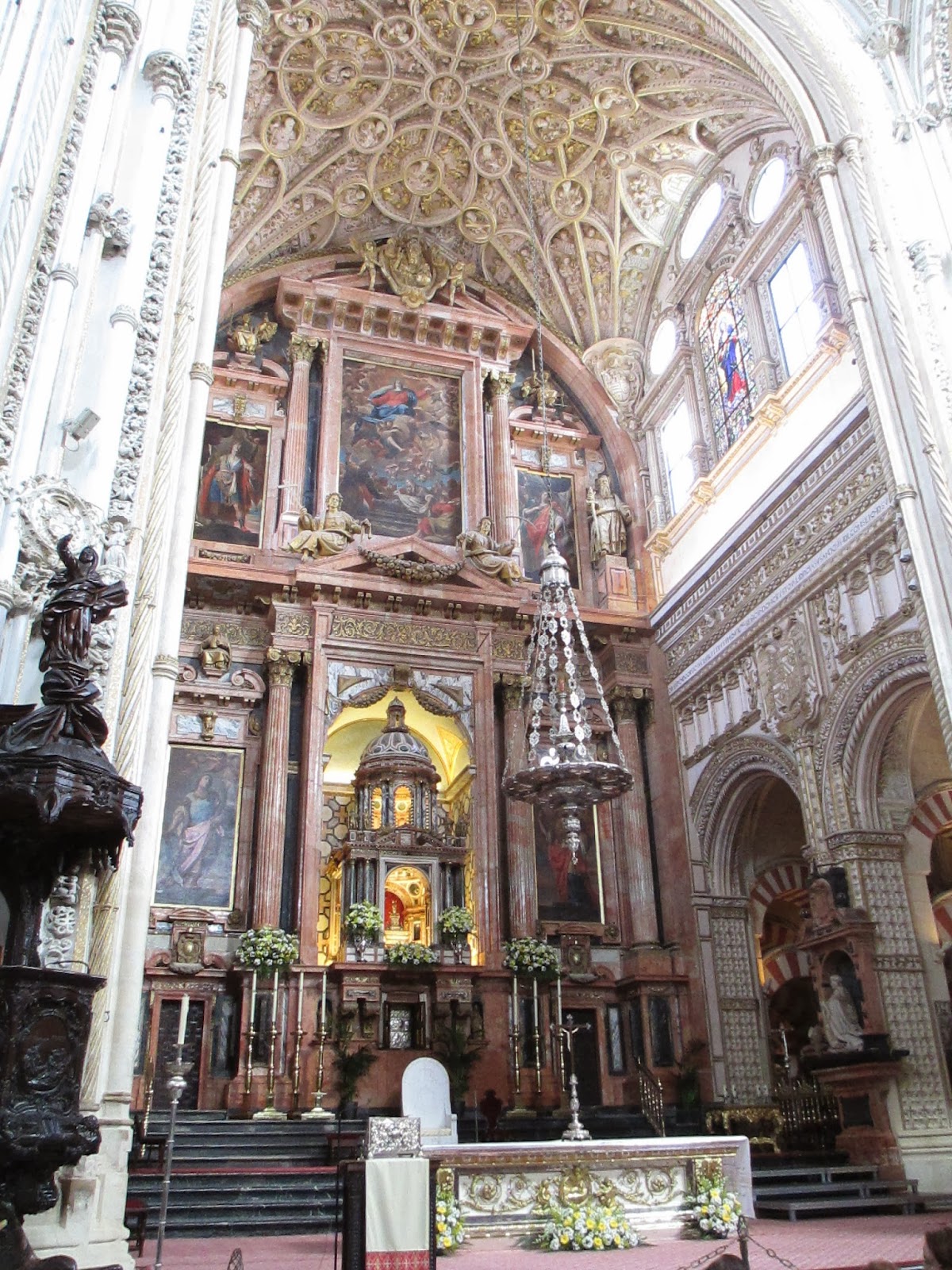Córdoba y Castilla-la Manchamost
Córdoba and Castile-La Mancha
Well I just took a trip with my family to Córdoba, a city which, in the Middle Ages was the cultural capital of Europe. It is in Andalucía (Andalusia in Enlglish) which is the part of Spain which most Americans think of when they think of Spain (if they don't decide to be super intelligent and think Spain is Mexico instead). Andalucía is when Córdoba, Sevilla (Seville), and Granada. We went there for the weekend to visit my host dad's mom but Fátima, my host sister, and I, went and saw the historic parts of the city.
Just like previous blog posts I will post the pictures of my trip with explanations thereof. I will also include several photographs not taken by myself to aide understanding of the various sites I have visited. These photos, though I think it perhaps superfluous judging by the quality of them, will be marked with an asterisk (*).
I hope you enjoy!
.png) |
| This is where Córdoba is on a Spanish map so that you have a reference point. |
 |
| Original gates and city walls from the Middle Ages |
First are the pictures from the city's medieval "judería" or Jewish district:
 |
| The old synagogue from the year 1315 |
 |
| Some shots of the interior |
 |
| Sign on the outside |
 |
| Cool old plaza next to the synagogue |
 |
| Fátima, who makes several guest appearances in this blog post |
 |
| Maimonides, (1135-1204) a famous Jewish rabbi, philosopher, and astronomer. |
Next comes the world famous Mosque-Cathedral of Córdoba. You may be wondering, how it can be a mosque and a cathedral at the same time. Construction was began in the year 781 and finished in 987. It was used as a mosque until 1236 when it was conquered by King Ferdinand III and converted into a cathedral. It is one of the top 3 most famous buildings in Spain and one of the most architecturally studied buildings in the entire world. The Mosque-Cathedral was also declared a World Heritage Site. I really do encourage you to check out the Wikipedia page because it has more professionally taken photos and history about this amazing building: Wikipedia: Mosque-Cathedral of Córdoba
.jpg) |
| An aerial view* |
 |
| Outer walls |
 |
| The Cathedral's tower (minaret) |
 |
| Inner patio and gardens |
 |
| First sign of Christian additions |
 |
| One of the interesting fountains in the patio |
 |
| The fountainhead |
At this point we went to go inside and were told they were closed. They said there was Mass at noon (it was Sunday so we were going to go anyway) and that we could return later at 3 for a tour. In the meantime, we explored the rest of Córdoba's historic disctrict.
 |
| Fountain of Saint Raphael the Archangel, Córdoba's patron saint. |
 |
| Fátima being a tourist in her own country. |
 |
| Arch of Triumph, 1572 (most people only recognise the large Arc de Triomphe in France but they're all over Europe) |
 |
| The Roman bridge, that comes up next |
 |
| Weird fountain |
 |
| We paid 1€ to go up to the top of the arc. The next few photos are the all the views we could see. |
 |
| Other side, really the front of the arch. |
What comes next is the Roman bridge, that is, build by the Romans in the first century. I couldn't believe I was standing on the something that old!
 |
| The bridge* |
 |
| The river |
 |
| Saint Raphael statue on the bridge |
 |
| Memorial across from Saint Raphael |
 |
| The plaque on the memorial reads: "This niche evokes the altar that was erected in this very spot in the 16th century, dedicated to the holy martyrs and patrons of Córdoba, Acisclus and Victoria. |
 |
| More bridge and Saint Raphael from the other side |
 |
| Cool tower at the other end of the bridge |
 |
| The entrance |
 |
| Inscription the on the arch |
We then made our way back to the Cathedral for Mass. Lots of older people were walking in with their families but when we tried to enter we were stopped by the security guard who said we couldn't go into the cathedral, apparently he found it inconceivable that two teenagers would be going to Mass. After some convincing that we're good practicing Catholics, we were allowed in. Mass turned out to be an amazing surprise. It was a pontifical Mass celebrating the jubilee year of the Trinitarian Order (a Roman Catholic religious order, e.g. Franciscans, Jesuits, etc.) celebrated by the bishop in the presence of the cathedral's canons, priests, monks, brothers, nuns, and a whole bunch of us faithful. After Mass we went an ate sandwiches and checked out some tourist shops. We then returned for our tour.
Prepare for lots and lots of photos
 |
| The windows, you'll note the Islamic influence throughout. |
 |
| The famous arches |
 |
| Stained-glass window |
 |
| One of the more than 100 chapels in the cathedral. Just as a side note, these chapels are all larger than most Catholic churches I've been in. |
 |
| What follows are some of the various chapels' signs with pictures of the chapel after them. I didn't take photos of all of them because that would take an amazing amount of time. |
 |
| The original floor |
 |
| Chapel of Saint Michael the archangel |
 |
| Related prize for anyone who, without internet help, posts what "QSD" on the shield means in the comments! |
 |
| Original ceiling |
 |
| Fátima was giving me grief for taking pictures of "everything but the bathroom", so I did. Also as a side note, she was taking as many photos as I was! |
The next few photographs are of the "mirhab" when muslims face when they pray. Note, the mosque part is no longer actually in use:
 |
| The mirhab* |
 |
| Famous painting of this part of the mosque in use. |
 |
| Some of the adapted parts |
 |
| Medieval memorials placed in the floor. |
 |
| Gothic ceiling |
 |
| Small image of the the seven sorrows of our Lady |
 |
| Some Renaissance additions |
 |
| Cool intricate column |
 |
| From a papal visti of Pope (soon to be saint!) John XXIII |
 |
| Another altar, there are lots |
 |
| The dedication, will work on a translation for that. |
 |
| Two skulls of saints who's names we couldn't find out |
Next is the main altar and church space:
 |
| The main altar* |
 |
| The ambo, from which the Gospel is proclaimed |
 |
| The choir, where the chathedral's canons would come to sing the Divine Office.* |
 |
| The organ |
 |
| The choir stalls, you will notice that the seat folds up and down, allowing those using them to sit and stand in their space. |
 |
| The ambo, from which is proclaimed the Epistle. |
 |
| So many photos! |
 |
| Despite all the cool, historical styles and additions, this one plaque is by far the most important part of the entire building. The inscription reads, with its list of names: "Priests of the diocese who gave their lives for Christ in the religious persecution." |
 |
| Fátima and I |
 |
| The Holy Oils |
 |
| Sarcophagus of Alfonso Fernandez of Montemayor, c. 1310. |
 |
| Corner stone, not from the Mosque, but added c. 968-969 |
 |
| Floor plan with the various additions |
 |
| Old liturgical books |
 |
| Medieval painting |
 |
| This big thing in this and the next two pictures is used to carry the Blessed Sacrament, the Body of Christ, in processions. Made of silver and gold c. 1510-1516 |
 |
| Silver missal stand |
 |
| Altar of Saint Teresa of Jesus |
 |
| Better view of the processional monstrance |
 |
| Gold-plated silver processional cross, 1620. |
 |
| Lignum Crucis or a piece of the cross upon which was crucified Jesus Christ. |
 |
| Pillar with gothic inscription |
 |
| Later engraving |
 |
| More Holy Oils |
 |
| Just a covering for a door in a side chapel but I was impressed by the work but into it so I took a picture. |
 |
| More of Saint Teresa of Jesus |
 |
| Inscriptions in Old Spanish in the main chapel |
 |
| Having a snack on the outside walls afterward |
 |
| This is Seneca, a Roman philosopher who was born in Córdoba |
 |
| Leaving the old city walls |
The next day, on our way back to Altea, we stopped through the Castilla-la Mancha, the land of the famous Don Quixote and Sancho Panza. It was amazing to be where he would of been! We stopped by a big lake and park and had lunch there. I think Castilla-la Mancha is my favourite part of Spain so far.
So that's my trip! I ask again, dear readers, your pardon, for the amount of arches shown in the blog post! Hope you enjoyed and as always, thanks for reading.
Pax & Βοnum,
Seán
.png)







.jpg)















































































































































































































